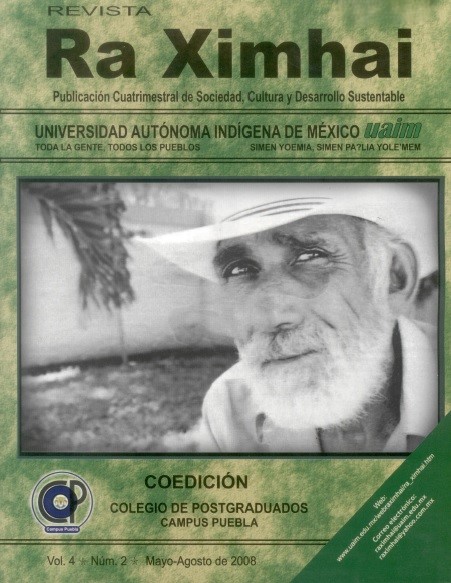The Zoques of Tuxtla and the dispute over the copoya virgins, in the central valley of Chiapas
DOI:
https://doi.org/10.35197/rx.04.02.2008.02.jcKeywords:
Zoque de Tuxtla, Virgen, CapoyaAbstract
Tuxtla Gutiérrez, capital of the current state of Chiapas, had its origin in a Zoque village called Coyatocmó. Later, with the presence of the Nahuas, it was called Tuxtlán (from Tochtlic, rabbit, and Tla, place or abundance). Its Chiapas neighbors knew it as Nacúa (from Ni-hú, rabbit); and the Tzotzils as Tulún (from t'ul, rabbit, and lum, land). That is to say, in any language, the area of the Zoque founders of Tuxtla is known as the house, place or land of rabbits, symbolized by a Nahua hieroglyph that represents a rabbit sitting on three grains of corn (Tovar, 1988; Morales, 1980). For its part, Copoya means “place of the full moon” or “where the moon shines.” It is located on the southeastern edge of the Zoque territory, on the southern shores of Tuxtla. It is a town of pre-Hispanic origin with a current population of 4,500 inhabitants. At the end of 2003, the first Catholic priest was appointed, since the “copoyeros” had not accepted the religious dominion of Tuxtla since its foundation by the Mercedarians in 1536; or the Dominicans in 1539 and the Franciscans between 1540 and 1541 (Carvalho, 1994:139). With the appointment of the priest, the population is divided between “encuentristas” from Copoya and “traditionalist Zoques” from Tuxtla, and the dispute for the possession of the virgins has begun. In March 2004, the first confrontation occurs, and in April violence takes over both sectors. Today both groups claim that things are calm, but the parishioners are co-opted in abundance and they grow separately. The brilliance with which the small Zoque community of Copoya was united with the great capital of Tuxtla has been lost, and they have moved on to a more popular and renewed religious phase. But… can hundreds of years of religious festivals be erased in which the virgins went up to Copoya and down to Tuxtla Gutiérrez?
Downloads
References
Aramoni Calderón, Dolores. 1992. Los refugios de lo sagrado. Religiosidad, conflicto y resistencia entre los zoques de Chiapas. Consejo Nacional para la Cultura y las Artes.
Delgadillo, Raquel, 1997. Población y estructura urbana en las colonias periféricas de Tuxtla Gutiérrez. En Aspectos Urbanos y Arquitectónicos de Tuxtla Gutiérrez. Cuadernos de Arquitectura y Urbanismo No. 3. Facultad de Arquitectura. Universidad Autónoma de Chiapas. México.
Escobar, Héctor. 1997. La Urbanización periférica de Tuxtla Gutiérrez. En Aspectos Urbanos y Arquitectónicos de Tuxtla Gutiérrez. Cuadernos de Arquitectura y Urbanismo No. 3. Facultad de Arquitectura, Universidad Autónoma de Chiapas. México.
Fábregas, P. A. 1985. La formación histórica de la frontera sur. CIESAS-Sureste y Cuadernos de la Casa Chata núm. 124, México.
Favre, Henri, 1973. Cambio y continuidad entre los mayas de México. Contribución al estudio de la situación colonial en América Latina. México, INI.
García de León, Antonio. 1985. Resistencia y Utopía. Memorial de agravios y crónica de revueltas y profecías acaecidas en la provincia de Chiapas durante los últimos quinientos años de su historia. Ediciones Era, México.
Malo, Clodoveo. 1997. La Dinámica de crecimiento demográfico de la ciudad de Tuxtla Gutiérrez. En Aspectos Urbanos y Arquitectónicos de Tuxtla Gutiérrez, Cuadernos de Arquitectura y Urbanismo No. 3, Facultad de Arquitectura, Universidad Autónoma de Chiapas.
Mérida Mancilla Arturo. 2000. Cien años de evolución urbana en Tuxtla Gutiérrez, Chiapas. Universidad Autónoma de Chiapas y H. Ayuntamiento Constitucional de Tuxtla Gutiérrez, Chiapas, México.
Morales Avendaño, Juan María, 1980. Pequeña monografía del municipio de Tuxtla Gutiérrez, Chiapas. Mimeo, Rincones de Chiapas, Colección Chiapas, Centro de Investigaciones Ecológicas del Sureste, CIES.
Noguez, Carlos. 1997. Cambios territoriales y transformaciones socioculturales en Tuxtla Gutiérrez: 1940-1995. En Aspectos Urbanos y Arquitectónicos de Tuxtla Gutiérrez, Cuadernos de Arquitectura y Urbanismo No. 3, Facultad de Arquitectura, Universidad Autónoma de Chiapas, México.
Rivera Farfán, Carolina, Miguel Lisbona y María del Carmen García. 2004. Chiapas Religioso. Dirección de Divulgación de la Secretaría de Educación, Gobierno de Chiapas, Tuxtla Gutiérrez, Chiapas, México.
Tovar González, María Elena. 1988. Tuxtla y su feria de San Marcos. Gobierno del Estado e Instituto Chiapaneco de Cultura.
Thompson, Roberto y María de L. Poo. 1985. Cronología histórica de Chiapas (1516- 1540) San Cristóbal de Las Casas, Chiapas. Centro de Investigaciones Ecológicas del Sureste.
Villasana Benítez, Susana. 1995. Cambios territoriales del área cultural zoque. Un seguimiento histórico. En Anuario IEI V, ed. Instituto de Estudios Indígenas, Universidad Autónoma de Chiapas, México.
Villa Rojas, Velasco T., Báez-Jorge, Córdova, D. Thomas. 1975. Los zoques de Chiapas. Colección SEP--INI núm. 39, Instituto Nacional Indigenista y Secretaría de Educación Pública, México.
Downloads
Published
How to Cite
Issue
Section
License
Copyright (c) 2008 Jorge Luis Cruz Burguete, Patricia Elizabeth Almazán Esquivel

This work is licensed under a Creative Commons Attribution-NonCommercial 4.0 International License.
Usted es libre de:
- Compartir — copiar y redistribuir el material en cualquier medio o formato
- Adaptar — remezclar, transformar y construir a partir del material
- La licenciante no puede revocar estas libertades en tanto usted siga los términos de la licencia
Bajo los siguientes términos:
- Atribución — Usted debe dar crédito de manera adecuada , brindar un enlace a la licencia, e indicar si se han realizado cambios . Puede hacerlo en cualquier forma razonable, pero no de forma tal que sugiera que usted o su uso tienen el apoyo de la licenciante.
- NoComercial — Usted no puede hacer uso del material con propósitos comerciales .
- No hay restricciones adicionales — No puede aplicar términos legales ni medidas tecnológicas que restrinjan legalmente a otras a hacer cualquier uso permitido por la licencia.








